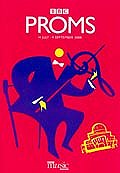 Concert Review
Concert Review
 Concert Review
Concert Review
PROM 61 Rimsky-Korsakov: Dubinushka, Op. 62, Copland:
Symphonic Ode Shostakovich: Symphony No. 11 in G minor, Op. 105 San Francisco
Symphony Orchestra Michael Tilson Thomas, conductor, RAH 31 Augsust 2000
(RW)
Apart from a visit to the Barbican by Tilson Thomas and the San Francisco on their European tour in 1996, this year's Proms were the first opportunity many will have had to hear what, on disc, has been one of the most dynamic of current partnerships. While yesterday's concert was more obviously a crowd puller, the present programme gave the orchestra its head in no uncertain terms.
Dubinushka, Rimsky's typically inventive and emotionally inscrutable arrangement of a Russian popular tune that reinforced his radical credentials after the 1905 massacre, provided an unanticipated, though apt curtain raiser. Tilson Thomas despatched it with vigourous efficiency - it might for all the world have been Sousa - before launching into a work he and the orchestra have made their own, Copland's Symphonic Ode. This major work from his early maturity (1928-9) has found few advocates: its thematic rigour and harmonic austerity place it in the lineage of such masterworks as Varese's Arcana and Ruggles's Sun-Treader, though the outwardly satisfying formal logic of Copland's design does not escape contrivance. In particular, the reprise of the scherzo music is far too brief and perfunctory to motivate the grand peroration of the closing pages. One wonders why Copland did not attend to this problem in his 1955 revision. Yet it does put a large orchestra convincingly through its paces, and the SFSO did full justice not only to the high-flown rhetoric, but also the finely sustained lyricism of the central slow section, powerfully moulded here. One of the more notable Proms premieres this year, and worth acquiring as part of RCA's excellent disc - Copland the Modernist [09026 68541-2].
Interest was considerable as to how Tilson Thomas would approach Shostakovich's Eleventh Symphony, a graphic and thoroughly ambivalent reflection on the events of 1905, written from the vantage point (1957) of another bloody suppression. Composer and conductor are not generally associated, and this is not a symphony where formal efficiency can compensate for lack of emotional input. There were some undeniably impressive passages: the opening of 'Palace Square' conveyed mystery and latent catastrophe at an impressively sustained dynamic level, while 'Eternal Memory' grew almost imperceptibly into a grave rendition of the eulogy 'You fell as heroes'. Tilson Thomas was considerably less successful at integrating the more graphically descriptive elements into the overall design. The lengthy build-ups of 'The Ninth of January' lacked inevitability, culminating in a massacre sequence more akin to 'The Rumble' from West Side Story in its emotional short-windedness, while the 'The Tocsin' was absurdly rushed ; even the pensive cor anglais solo prior to the coda lacking gravitas. As elsewhere in Shostakovich, shadow-boxing is no substitute for the conveying of genuine emotion, and a tangible sense of anger and frustration was in short supply here. Tilson Thomas conducted as though living every note, and maybe, for the duration, he did.
Richard Whitehouse
Seen&Heard is part of Music on the Web(UK) Webmaster: Len Mullenger Len@musicweb-international.com
Return to: Seen&Heard Index
 Return to:
Music on the Web
Return to:
Music on the Web